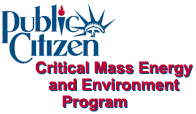
Testimony of Wenonah
Hauter
Critical Mass Energy Project Director, Public Citizen
on the
Department of Energy’s
Draft Environmental Impact Statement for
a
Geologic Repository for the Disposal of Spent Nuclear Fuel
and
High-Level Radioactive Waste at Yucca Mountain, Nye County,
Nevada
October 26, 1999
Thank you for the opportunity to testify regarding the Department of Energy’s Draft Environmental Impact Statement for a Geologic Repository for the Disposal of Spent Nuclear Fuel and High-Level Radioactive Waste at Yucca Mountain. I will be following up my testimony today with detailed written comments.
I am the Director of the Critical Mass Energy Project of Public Citizen, a non-profit research, lobbying, and litigation organization founded by Ralph Nader in 1971. Public Citizen advocates for consumer protection and for government and corporate accountability, and is supported by over 150,000 members throughout the United States.
DOE’s Draft Environmental Impact statement does not adequately address the vast number of public health, environmental, and socioeconomic impacts of a geologic repository for nuclear waste at Yucca Mountain, Nevada.
Because the proposed repository is such an unprecedented endeavor, every effort must be made to explore the consequences of each and every action associated with building, monitoring, and closing the repository, as well as transporting the waste to the repository. For fifty years, this country has shied away from confronting the problems that the nuclear age has caused, and it is vital that we insist upon looking these problems in the face, finding sound solutions, and honestly characterizing the results of our decisions. In addition, it is crucial to include the public in these decisions, so that citizens are informed of the potential risks and possible benefits of any decisions made regarding nuclear waste. A project of this magnitude will be dependent upon public support for its success.
The DEIS does not adequately consider the impacts of transporting the waste materials to Yucca Mountain. In Chapter 3, "Affected Environment," DOE notes that the region of influence for public health and safety along existing transportation routes is 800 meters (.5 mile) from the center line of transportation rights-of-way for non-accident conditions, and 80 kilometers (50 miles) for accident conditions.
However, the DEIS neither shows specific routes outside of Nevada to be used to transport waste materials, nor addresses the baseline conditions along those routes. In order to do a complete impact analysis, DOE should map specific routes and establish baseline conditions along those routes, as well as clearly and honestly identify potential impacts along those routes.
The truth is that radioactive waste will need to travel through 43 states, past the homes, workplaces, schools, and hospitals of 50 million Americans to get to Yucca Mountain. Those 50 million Americans have a right to be informed about the risks associated with transporting nuclear waste and the impacts on public health and environment that will occur from the transportation.
Further, the DEIS fails to address the fact that the number of shipments and the amount of radioactive material that will be shipped is unprecedented in world history. About 90% of the volume would be spent fuel from nuclear power plants, and virtually none of this type of material has ever been shipped before. Not only is it not known what type of container would be used to transport nuclear waste, but also these containers have been neither constructed nor tested—therefore, the impact statement is incomplete.
In addition, the DEIS does not examine what emergency response personnel training and equipment would be needed in all of the communities along the transportation routes and what the specific impacts of a transportation accident would be. The DEIS also does not address the impact of several thousands of nuclear waste shipments along transportation routes on property values and community economies.
Clark County, Nevada, has the fastest growing economy in the United States and the 10th largest school district in the country. The DEIS fails to recognize the immense impact a nuclear waste dump located in the next county over could have on such a booming economy. It does not address how the health of several thousand schoolchildren will be affected. Further, the number of retirees moving to this area is increasing by the year. The DEIS does not address the potential impacts to individuals living in retirement communities or nursing homes (essentially captive receptors of radiation) in the area of Yucca Mountain or along transportation routes.
Other issues not adequately discussed in the DEIS are the possibility for groundwater upwelling and earthquakes at the repository site. DOE states that "Several investigators have suggested that the water table in the vicinity of Yucca Mountain has risen dramatically higher than 100 meters (330 feet) above the current level, even reaching the land surface in the past (Szymanksi, 1989, all). If such an event occurred, it would affect the performance of the proposed repository" (p. 3-49). Yet, the DEIS dismisses this possibility and does not address the potential impacts of such an event.
DOE notes another opposing viewpoint by Davies and Archambeau (1997) which suggests that a moderate earthquake at the sight could result in a water table rise of about 150 meters (490 feet) and a severe earthquake could cause a rise of about 240 meters (790 feet) in the water table, which would flood the repository. DOE has repeatedly ignored the potential impacts of earthquakes at the Yucca Mountain site, rejecting them as unlikely, even though Nevada ranks third in the nation for current seismic activity, and since 1976, there have beenover 600 seismic events of a magnitude greater than 2.5 within a 50-mile radius of Yucca Mountain (Council of the National Seismic System Composite Catalog, 1976 to present, Southern Great Basin Seismic Network).
Finally, the No-Action Alternative in the DEIS is simply not satisfactory. The characterization of the No-Action Alternative is a blatant scare tactic on DOE’s part to mask the dangers of a permanent geologic repository at Yucca Mountain.
Thank you for your consideration of my testimony.